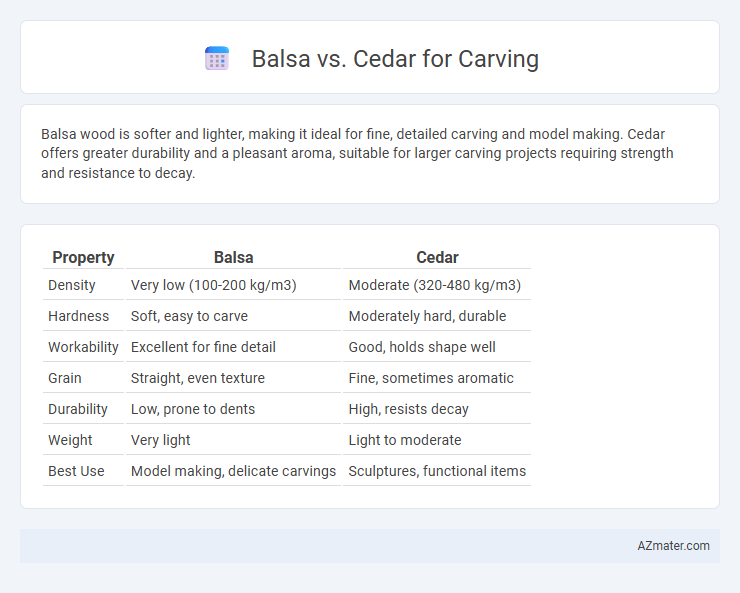Balsa wood is softer and lighter, making it ideal for fine, detailed carving and model making. Cedar offers greater durability and a pleasant aroma, suitable for larger carving projects requiring strength and resistance to decay.
Table of Comparison
| Property | Balsa | Cedar |
|---|---|---|
| Density | Very low (100-200 kg/m3) | Moderate (320-480 kg/m3) |
| Hardness | Soft, easy to carve | Moderately hard, durable |
| Workability | Excellent for fine detail | Good, holds shape well |
| Grain | Straight, even texture | Fine, sometimes aromatic |
| Durability | Low, prone to dents | High, resists decay |
| Weight | Very light | Light to moderate |
| Best Use | Model making, delicate carvings | Sculptures, functional items |
Introduction to Balsa and Cedar for Carving
Balsa and cedar are popular woods for carving due to their unique properties and workability. Balsa is renowned for its lightweight and soft texture, allowing for easy shaping and fine detail work, ideal for beginners and intricate models. Cedar offers a balance of softness and durability with a distinctive aromatic quality, making it suitable for skilled carvers seeking both beauty and resilience in their projects.
Wood Grain and Texture Comparison
Balsa wood features a very soft, fine, and uniform grain with a smooth texture, making it ideal for intricate and detailed carving projects that require precision. Cedar wood typically has a coarser, more pronounced grain with a softer texture that offers moderate resistance to carving, allowing for natural, rustic finishes. The distinct grain patterns of cedar provide aesthetic appeal in carvings, while balsa's lighter weight and finer grain facilitate easier shaping and sanding.
Workability: Ease of Carving
Balsa wood is renowned for its exceptional softness and lightweight properties, making it the easiest material to carve with minimal effort and sharp tools. Cedar, while also relatively soft, has a denser grain and natural oils that can slightly resist carving but offer better durability in finished projects. For beginners and detailed work, balsa provides superior workability, whereas cedar suits carvers seeking a balance between ease and toughness.
Durability and Strength Differences
Balsa wood is exceptionally lightweight with low density, making it easy to carve but less durable and prone to dents and breaks under stress. Cedar offers greater strength and durability with a tighter grain structure, allowing for more resilient carvings that withstand wear and environmental factors better. For projects requiring long-lasting, sturdy carvings, cedar is generally the superior choice compared to the softer, more fragile balsa.
Weight and Handling Considerations
Balsa wood is significantly lighter than cedar, making it ideal for carving projects where reduced weight is essential, such as model building or delicate sculptures. Cedar, although heavier, offers greater strength and durability, enhancing handling stability and resistance to damage during carving. Choosing between balsa and cedar depends on the need for lightweight ease versus robust handling and longevity in the finished piece.
Finish and Paint Absorption
Balsa wood, known for its lightweight and porous structure, offers excellent paint absorption, resulting in vibrant finishes but often requires multiple coats for smoothness. Cedar, with its tight grain and natural oils, provides a smoother surface finish but can repel paint, necessitating a primer for even coverage. Both woods respond well to sealants, but balsa is preferred when a lightweight, highly absorbent material is needed, while cedar is ideal for durable carvings with a refined finish.
Cost and Availability
Balsa wood is significantly more affordable and widely available compared to cedar, making it a popular choice for budget-conscious carvers seeking lightweight materials. Cedar tends to be more expensive due to its durability and resistance to decay, and its availability can be limited in some regions. Carvers often choose balsa for large-scale projects because of its cost-effectiveness and easy accessibility, while cedar is preferred for smaller, detailed carvings where longevity is crucial.
Suitability for Detailed Carving
Balsa wood offers superior softness and low density, making it highly suitable for detailed carving and intricate designs, especially for beginners or delicate projects. Cedar, while slightly harder and more aromatic, provides a tighter grain that allows for finer detail but may require sharper tools and more skill to achieve precision. Both woods are favored in carving, but balsa's lightweight nature and ease of cutting give it an edge for intricate, detailed work.
Common Uses in Carving Projects
Balsa wood is favored for carving lightweight models, prototypes, and intricate craft projects due to its softness and ease of shaping. Cedar is preferred for carving outdoor items like totem poles, decorative panels, and furniture because of its durability and natural resistance to decay. Both woods suit different carving needs: balsa excels in fine detail and lightness, while cedar offers resilience for larger, lasting pieces.
Choosing the Right Wood: Balsa or Cedar?
Balsa wood offers exceptional softness and lightweight properties ideal for intricate carving projects requiring fine details, while cedar provides a balance of moderate hardness and natural aromatic oils that enhance durability and resist decay. Selecting between balsa and cedar depends on the project's needs: balsa suits delicate, lightweight carvings, whereas cedar excels in outdoor or longer-lasting applications due to its resilience. Consider grain texture, workability, and environmental exposure when choosing the right wood for carving to ensure optimal performance and finish quality.

Infographic: Balsa vs Cedar for Carving
 azmater.com
azmater.com